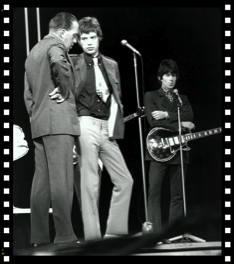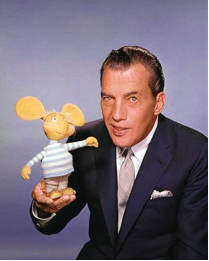HISTORY OF THE ED SULLIVAN SHOW
The Ed Sullivan Show aired from 1948 until 1971 and changed the landscape of American television. Sullivan’s stage was home to iconic performances by groundbreaking artists from rock ‘n’ roll, comedy, novelty, pop music, politics, sports, opera and more.
There were historic rock ‘n’ roll performances by The Beatles, Elvis Presley, Rolling Stones and The Doors; sensational Motown acts by The Jackson 5, Supremes and Temptations; hilarious stand-up comedy acts by Richard Pryor, Rodney Dangerfield, George Carlin and Carol Burnett; unforgettable Broadway performances by the stars of musicals like My Fair Lady and West Side Story. This list of who stepped on The Ed Sullivan Show stage goes on and on.
You might be wondering — how did The Ed Sullivan Show become the home to the top talent and historical performances of its era?
Often, talk show hosts are charming and competent on camera, yet maybe not the most business-savvy off-screen. Ed Sullivan was just the opposite—pasty in the bright lights, shifty in his stance, and notorious for bungling introductions and monologues.
Ironically, that high discomfort factor helped develop the cult of Ed. There was just something novel about an awkward host, and like a fender bender on the side of the highway, people just couldn’t avert their gaze.
Off camera, Sullivan was a brilliant tracker and arranger of talent. A variety show always has variety, but nothing was as eclectic as the mish-mash that Sullivan put together, from puppet shows to opera, the show had it all.
There were countless acts and performers who made their debuts—or their most famous TV outings—on his show. Ed Sullivan had his finger right on the pulse of what was hot and intriguing in the way of talent, even if he himself didn’t have a discernible pulse onstage. Ed knew how to book ‘em better than anyone.
In 1948, CBS hired Sullivan to host its first variety show endeavor, a new format that combined vaudeville with television and was nicknamed “vaudeo.” The show was called The Toast of the Town.
For his inaugural program, Sullivan assembled Dean Martin and Jerry Lewis, Rodgers and Hammerstein, a pianist, a ballerina, a troupe of crooning firemen and a boxing referee whose next gig was the Joe Louis-Jersey Joe Wolcott match. If you wanted to see the phrase ‘something for everyone’ incarnate, there it was.
The critics were rough on Sullivan—they lambasted him for his wooden hosting style and the scattershot tone of his guest menageries. But the show did well anyway.
In 1955, its name changed to The Ed Sullivan Show, and the following year, it broke all of TV’s single night ratings counts when a young Elvis Presley swiveled that famous pelvis on Sullivan’s stage.
June Taylor provided her six dancing “Toastettes,” Ray Bloch led his orchestra, and Sullivan was a Sunday night institution soon enough. Producer Marlo Lewis decided during rehearsals how long each act would last, what order the acts would appear in, and what, out of each performer’s cache of material, should be performed.
A sampling of the people who made their American TV debuts on Sullivan’s show includes: Bob Hope, Lena Horne, Martin and Lewis, Dinah Shore, Albert Schweitzer, Irving Berlin, Fred Astaire and Jane Powell, Eddie Fisher, and most famously, The Beatles.
Most Americans got their first exposure to The Beatles from the historic Ed Sullivan Show broadcast on February 9, 1964. That episode remains one of the most highly watched single shows in TV history. Following which, the “Beatlemania” phenomenon commenced, and the floodgates for other British bands coming to America were opened.
Since hip, cutting-edge musical acts were clearly treating him right, Sullivan responded by booking The Rolling Stones, The Doors, Janis Joplin, Marvin Gaye and Bob Dylan, though Dylan jumped ship when the network wouldn’t let him sing “Talkin’ John Birch Society Blues,” a song about an over-zealous Communist seeker. Not that this was Sullivan’s only problem with emerging rockers: The Stones were banned (temporarily, it turned out) after their rowdy first appearance, and the show’s director asked The Doors to leave out the line “girl we couldn’t get much higher” from “Light My Fire” (they agreed, sang it anyway, and likewise got banned).
Sullivan’s celebrity guests sat in the audience, not backstage in a fancily-catered green room, and sometimes when the acts were introduced, they came right from the audience to the stage. Once in a while, with no prior planning, he’d invite them back up for additional performance.
His interplay with mechanical Italian mouse Topo Gigio, and Señor Wences and his talking box (“S-all right? S-all right!”) showed a soft side on camera, but once again, since the man was a dichotomy, don’t ever think he was all softie.
The Ed Sullivan Show was the quintessential variety show. Whether it was Broadway for the parents, rock ‘n’ roll for the teenagers or Topo Gigio for the kids, the show had something for everyone. From 1948 to 1971, The Ed Sullivan Show was special in that it brought people and families together every Sunday evening. The Ed Sullivan Show was the longest-running variety show in TV history, and an undisputed institution. Towards the end of that long run, with the country divided by Vietnam and shifting value systems, Sullivan’s catchall format didn’t cross the demographic lines like it used to. Time slot rivals The Walt Disney Show and The F.B.I. were gaining momentum, and CBS, eager for youth-oriented programming and fearful that Sullivan was a vestige of older generations, canceled the show.
No matter. Guts and diversity like that, which goes for the show and the man, tend to stick around in a person’s (and a country’s) consciousness.


